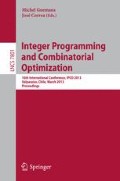Abstract
In the Packing Interdiction problem we are given a packing LP together with a separate interdiction cost for each LP variable and a global interdiction budget. Our goal is to harm the LP: which variables should we forbid the LP from using (subject to forbidding variables of total interdiction cost at most the budget) in order to minimize the value of the resulting LP? Interdiction problems on graphs (interdicting the maximum flow, the shortest path, the minimum spanning tree, etc.) have been considered before; here we initiate a study of interdicting packing linear programs. Zenklusen showed that matching interdiction, a special case, is NP-hard and gave a 4-approximation for unit edge weights. We obtain an constant-factor approximation to the matching interdiction problem without the unit weight assumption. This is a corollary of our main result, an O(logq · min {q, logk})-approximation to Packing Interdiction where q is the row-sparsity of the packing LP and k is the column-sparsity.
Access this chapter
Tax calculation will be finalised at checkout
Purchases are for personal use only
Preview
Unable to display preview. Download preview PDF.
References
Phillips, C.A.: The network inhibition problem. In: Proceedings of the Twenty-Fifth Annual ACM Symposium on Theory of Computing, STOC 1993, pp. 776–785 (1993)
Burch, C., Carr, R., Krumke, S., Marathe, M., Phillips, C., Sundberg, E.: A decomposition-based pseudoapproximation algorithm for network flow inhibition. In: Network Interdiction and Stochastic Integer Programming, pp. 51–68 (2003)
Wood, R.: Deterministic network interdiction. Mathematical and Computer Modelling 17, 1–18 (1993)
Zenklusen, R.: Network flow interdiction on planar graphs. Discrete Appl. Math. 158, 1441–1455 (2010)
Fulkerson, D.R., Harding, G.C.: Maximizing Minimum Source-Sink Path Subject To A Budget Constraint. Mathematical Programming 13, 116–118 (1977)
Israeli, E., Wood, R.K.: Shortest-path network interdiction. Networks 40, 2002 (2002)
Frederickson, G.N., Solis-Oba, R.: Increasing the weight of minimum spanning trees. In: SODA 1996, pp. 539–546 (1996)
Zenklusen, R.: Matching interdiction. Discrete Appl. Math. 158, 1676–1690 (2010)
Zenklusen, R., Ries, B., Picouleau, C., de Werra, D., Costa, M.C., Bentz, C.: Blockers and transversals. Discrete Mathematics 309, 4306–4314 (2009)
Kasiviswanathan, S.P., Pan, F.: Matrix Interdiction Problem. In: Lodi, A., Milano, M., Toth, P. (eds.) CPAIOR 2010. LNCS, vol. 6140, pp. 219–231. Springer, Heidelberg (2010)
Könemann, J., Parekh, O., Segev, D.: A unified approach to approximating partial covering problems. Algorithmica 59, 489–509 (2011)
Kearns, M.J.: The computational complexity of machine learning. PhD thesis, Harvard University, Cambridge, MA, USA (1990)
Slavík, P.: Improved performance of the greedy algorithm for partial cover. Inf. Process. Lett. 64, 251–254 (1997)
Bar-Yehuda, R.: Using homogeneous weights for approximating the partial cover problem. J. Algorithms 39, 137–144 (2001)
Fujito, T.: On approximation of the submodular set cover problem. Oper. Res. Lett. 25, 169–174 (1999)
Bar-Yehuda, R., Even, S.: A linear-time approximation algorithm for the weighted vertex cover problem. Journal of Algorithms 2, 198–203 (1981)
Author information
Authors and Affiliations
Editor information
Editors and Affiliations
Rights and permissions
Copyright information
© 2013 Springer-Verlag Berlin Heidelberg
About this paper
Cite this paper
Dinitz, M., Gupta, A. (2013). Packing Interdiction and Partial Covering Problems. In: Goemans, M., Correa, J. (eds) Integer Programming and Combinatorial Optimization. IPCO 2013. Lecture Notes in Computer Science, vol 7801. Springer, Berlin, Heidelberg. https://doi.org/10.1007/978-3-642-36694-9_14
Download citation
DOI: https://doi.org/10.1007/978-3-642-36694-9_14
Publisher Name: Springer, Berlin, Heidelberg
Print ISBN: 978-3-642-36693-2
Online ISBN: 978-3-642-36694-9
eBook Packages: Computer ScienceComputer Science (R0)

